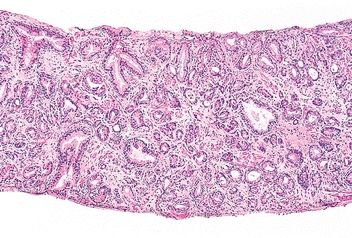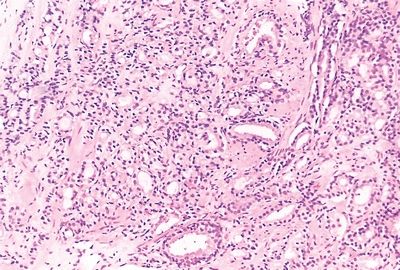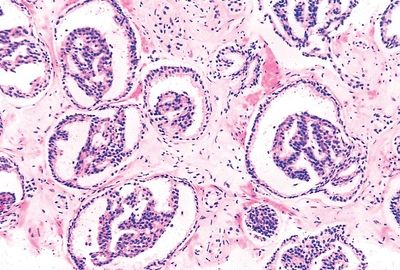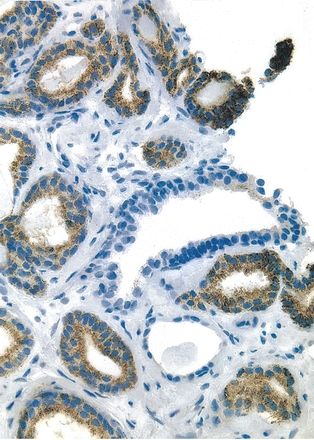QUESTION 45.2
A. Allergic reaction
B. Infarct
C. Mycobacterial infection
D. Previous biopsy
E. Rupture of ducts and acini
3. Besides age, which of the following is a well- recognized factor that influences the incidence of prostatic carcinoma?
A. Exposure to environmental toxins
B. Fat consumption
C. Nodular hyperplasia
D. Race
E. Vitamin A intake
4. Which of the following stages indicates a nonpalpable prostatic carcinoma detected by needle biopsy?
A. T1a
B. T1b
C. T1c
D. T2
E. T3
5. In regard to prostate cancer screening, which of the following is true?
A. Complex form of prostate-specific antigen (PSA) is released predominantly by hyperplastic prostate
B. False-negative rate of core biopsies is approximately 25%
C. Free form of PSA is released predominantly by prostate cancer
D. Transrectal ultrasonography (TRUS) has a 95% sensitivity
E. Tumor seeding after transrectal needle biopsy is not uncommon
6. A prostatic carcinoma is detected by needle biopsy. The tumor has only one pattern, which is illustrated in this picture. Which of the following is the corresponding Gleason score?

QUESTION 45.6
A. 2
B. 3
C. 6
D. 9
E. 10
7. A prostatic carcinoma is detected by needle biopsy. This photomicrograph shows the tumor’s dominant pattern (on the lower right) and secondary pattern (on the upper left). Which of the following is the corresponding Gleason score?

QUESTION 45.7
A. 3
B. 5
C. 7
D. 9
E. 10
8. Gleason score assessed in needle biopsies is a powerful predictor of the pathologic findings in prostatectomy specimens, prognosis after radical prostatectomy, and prognosis following radiotherapy. Which of the following Gleason scores represents the major divide between low-risk and medium-risk prostate cancer?
A. 2 to 3
B. 4 to 5
C. 5 to 6
D. 6 to 7
E. 7 to 8
9. Which of the following histopathologic features in a prostatic biopsy favors a diagnosis of adenocarcinoma over that of prostatic hyperplasia?
A. Atrophic glands
B. Conspicuous nucleoli
B. Corpora amylacea
D. Inflammatory infiltrate
E. Large glands with papillary infoldings
10. A prostatic needle biopsy from a patient with an elevated serum PSA is submitted for histopathologic evaluation. Most of the tissue in the biopsy consists of normal glands and stroma, but there is a small focus of crowded small glands suspicious for malignancy. In this context, which of the following parameters is most helpful in making a diagnosis of cancer?
A. Amphophilic cytoplasm
B. Blue-tinged mucinous secretions
C. Intraluminal crystalloids
D. Mitoses
E. Nuclear hyperchromasia/enlargement
F. Prominent nucleoli
G. Sharp luminal borders
H. All of the above
11. A prostatic needle biopsy reveals the lesion shown in this photomicrograph. Which of the following is the most likely diagnosis?

QUESTION 45.11
A. Adenocarcinoma
B. Atrophic gland
C. Atypical adenomatous hyperplasia (adenosis)
D. Benign prostatic hyperplasia
E. Mucous gland metaplasia
12. A section of a prostatic needle biopsy is immunohistochemically stained for alpha-methyl acyl-CoA racemase (AMACR). The result is shown in this picture. Which of the following is the most likely diagnosis?

QUESTION 45.12
A. Adenocarcinoma
B. Atrophic gland
C. Atypical adenomatous hyperplasia (adenosis)
D. Benign prostatic hyperplasia
E. Mucous gland metaplasia
13. In transurethral prostate resection (TUR) specimens, which of the following parameters is most helpful in the differential diagnosis between prostatic atypical adenomatous hyperplasia (adenosis) and low-grade adenocarcinoma?
Stay updated, free articles. Join our Telegram channel

Full access? Get Clinical Tree


